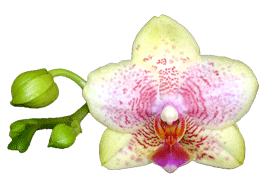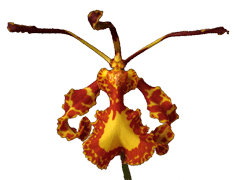What kind of Orchid Pots should I use?
 Orchids do not grow in pots in the wild. We put them in pots for our convenience. As a result we must understand how strange this is for the plant, their roots like to breath and be free. It is perfectly fine for orchid roots to grow outside of the pot. Unfortunately, our homes are not humid enough to support epiphytes well. So, a pot helps by holding some moisture around the roots. The secret to growing healthy orchids is to grow healthy roots. Ordinary potted plants are judged by their leaf growth. For orchids, the root growth is the best indicator of the health of the plant. For orchids grown in pots we must be extra careful not to rot or smother the roots. Orchids do not grow in pots in the wild. We put them in pots for our convenience. As a result we must understand how strange this is for the plant, their roots like to breath and be free. It is perfectly fine for orchid roots to grow outside of the pot. Unfortunately, our homes are not humid enough to support epiphytes well. So, a pot helps by holding some moisture around the roots. The secret to growing healthy orchids is to grow healthy roots. Ordinary potted plants are judged by their leaf growth. For orchids, the root growth is the best indicator of the health of the plant. For orchids grown in pots we must be extra careful not to rot or smother the roots.
Because obtaining a good moisture balance is so very critical to optimal orchid care many orchid growers choose clear orchid pots so that it is easier to see when the roots are thriving and when they are not. It is believed that orchid roots engage in photosynthesis, which makes sense given that they grow exposed to dappled light as the orchid hangs from a tree, and clear pots make photosynthesis by orchid roots possible. White pots also allow some light to pass through them.
Pot your orchids in the smallest pot that the roots will fit in and stake the plant while it establishes itself. The orchids we've seen grow the best are often growing in what appears to be ridiculously small pots so resist the urge to 'pot up' any more than is absolutely necessary to hold the roots. Clear plastic pots make it easy to see the roots and to see when to water. The potting mix turns dark when wet and gradually lightens as it dries. White palstic pots also allow for some photosynthesis while being a very attractive choice for display as well. Unlike clay, plastic pots are easy to clean, disinfect, and reuse. Clear plastic pots are a great way to keep an eye on what is happening in the pot without having to disturb the plant.
What about Orchid Fertilizer?
 Orchids require special fertilizer designed for orchids to grow really well. A common ingredient in many off-the-shelf fertilizer formulas is Urea which is not well absorbed by orchids. As a result, it is best to obtain a fertilizer that is made for orchid care. The gold standard for orchid fertilizer is based upon a formula created as the result of a study at Michigan State University (MSU). Orchids do not require very much fertilizer; a diluted amount on a regular basis is optimal for orchid care. Most orchid growers recommend fertilizing "weakly, weekly". Orchids require special fertilizer designed for orchids to grow really well. A common ingredient in many off-the-shelf fertilizer formulas is Urea which is not well absorbed by orchids. As a result, it is best to obtain a fertilizer that is made for orchid care. The gold standard for orchid fertilizer is based upon a formula created as the result of a study at Michigan State University (MSU). Orchids do not require very much fertilizer; a diluted amount on a regular basis is optimal for orchid care. Most orchid growers recommend fertilizing "weakly, weekly".
When watering flush the plants with water freely. Many people take orchids to the sink in order to flood them with water periodically. Our favorite saying is "once around the bench gets them damp, twice around the bench gets them wet, three times around the bench gets oxygen to the roots". It is oxygen to the roots that orchids need and they will get it from a combination of a good open mix and proper watering habits.
How does humidity and air movement affect orchids?
 Orchids do not like 'wet feet' but they do very much like humidity. As a result, when grown inside a home orchids are often placed on humiditu trays . These trays allow water to collect in the base while the plant is suspended above the water. Commercial trays are available or a tray can be created from a cake pan filled with stones or inverted pot saucers, anything to allow the orchid pot to be above a pool of water. In this way the orchid benefits from the evaporation of the water. Orchids also like to be gathered close together as this also helps to raise the humidity among the plants. This is invariably a balancing act because orchids also like air movement but constant movement of dry air will dry out the plants. Too much moisture and too little air movement and the plants may become susceptible to rot. Achieving a good balance of humidity and air movement is one of the goals of successful orchid care. Orchids do not like 'wet feet' but they do very much like humidity. As a result, when grown inside a home orchids are often placed on humiditu trays . These trays allow water to collect in the base while the plant is suspended above the water. Commercial trays are available or a tray can be created from a cake pan filled with stones or inverted pot saucers, anything to allow the orchid pot to be above a pool of water. In this way the orchid benefits from the evaporation of the water. Orchids also like to be gathered close together as this also helps to raise the humidity among the plants. This is invariably a balancing act because orchids also like air movement but constant movement of dry air will dry out the plants. Too much moisture and too little air movement and the plants may become susceptible to rot. Achieving a good balance of humidity and air movement is one of the goals of successful orchid care.
What are the light requirements of orchids?
 Orchids have very widely varying light needs and understanding the appropriate amount of light for the type of orchid is essential to their care. Even 'high light' orchids do not require the kind of bright direct sunshine that a tomato plant does and even 'low light' orchids will not be happy indefinitely in the middle of a room far from any light source. Even a North window can be too little light for low light orchids to bloom reliably but a South window may need some shading. In fact, it is often inadequate light that inhibits orchid blooming. Some orchids, especially those which like high light levels, enjoy being summered outside in dappled shade and for many high light orchids that is the easiest way, to give them enough light to bloom. If high light orchids are to remain indoors, many will not bloom reliably without some sort of supplemental light unless they are in a very bright sun room or greenhouse. Fortunately, fluorescent bulbs with broad spectrum bulbs work fairly well with orchids, as do High Intensity Discharge (HID) lights. Also, in nature orchids get natural light cues. The days get longer and then get shorter. In our homes we have supplemental lighting and tend to keep a regular schedule year-round and this can throw off an orchid's natural clock. Orchids have very widely varying light needs and understanding the appropriate amount of light for the type of orchid is essential to their care. Even 'high light' orchids do not require the kind of bright direct sunshine that a tomato plant does and even 'low light' orchids will not be happy indefinitely in the middle of a room far from any light source. Even a North window can be too little light for low light orchids to bloom reliably but a South window may need some shading. In fact, it is often inadequate light that inhibits orchid blooming. Some orchids, especially those which like high light levels, enjoy being summered outside in dappled shade and for many high light orchids that is the easiest way, to give them enough light to bloom. If high light orchids are to remain indoors, many will not bloom reliably without some sort of supplemental light unless they are in a very bright sun room or greenhouse. Fortunately, fluorescent bulbs with broad spectrum bulbs work fairly well with orchids, as do High Intensity Discharge (HID) lights. Also, in nature orchids get natural light cues. The days get longer and then get shorter. In our homes we have supplemental lighting and tend to keep a regular schedule year-round and this can throw off an orchid's natural clock.
What temperature do orchids require?
 Some orchids use the chill in the Fall air or the difference between the temperature at night and the temperature during the day as a cue to let them know the seasons are changing and it is time to prepare to bloom. Again, the fact that many people prefer a fairly consistent temperature in their homes is at odds with the orchid's natural environment. That does not mean that all is lost, it is just to emphasize that knowing the needs of the type of orchid that you are trying to provide care for will allow you to make small adjustments to meet those needs and be rewarded with beautiful orchid blooms. Some orchids are naturally warm growing while others are intermediate or cool growing but most will do OK in intermediate conditions where it isn't blazing hot nor near freezing cold. It is good to know the temperate preferences of the orchids in your collection. Often there is some variance, for example, cooler growing orchids can be put closer to a cool window or in a cooler spot in a home. Some orchids use the chill in the Fall air or the difference between the temperature at night and the temperature during the day as a cue to let them know the seasons are changing and it is time to prepare to bloom. Again, the fact that many people prefer a fairly consistent temperature in their homes is at odds with the orchid's natural environment. That does not mean that all is lost, it is just to emphasize that knowing the needs of the type of orchid that you are trying to provide care for will allow you to make small adjustments to meet those needs and be rewarded with beautiful orchid blooms. Some orchids are naturally warm growing while others are intermediate or cool growing but most will do OK in intermediate conditions where it isn't blazing hot nor near freezing cold. It is good to know the temperate preferences of the orchids in your collection. Often there is some variance, for example, cooler growing orchids can be put closer to a cool window or in a cooler spot in a home.
How should orchids be watered?
 Proper orchid watering is probably the single most difficult aspect of orchid care to get right. The appropriate amount of water for an orchid varies with the type of orchid, the type of mix it is in, and the environment in which the orchid is growing. This is as difficult for beginners as using a recipe that suggests that a dish be "baked until done", what does that mean? Orchids want the 'right' amount of water, not too much and not too little. The right amount also varies with the seasons, orchids dry out more quickly when it is hot then when it is cold. The key is to vary the frequency of orchid watering, the type of pot, the type of mix, how tightly the mix is packed and the amount of air circulation until the right balance is achieved for each orchid. This takes time and patience but pays off with increased health and vigor of the orchid which translates into increased blooms. The one thing to avoid is to limit the amount of water that an orchid is given during a watering. By & large one is met with the greatest success when an orchid is watered liberally, allowing the water to pour from the bottom of the pot, until the plant and media are completely saturated. From a practical standpoint this usually means bringing the orchid to the sink and running water liberally through the mix. In some cases one can water an orchid on its humidity tray especially if that tray has a drain in case the water level gets too high. Once the orchid has been watered it should go back to its growing space until the next watering which may be anything from a few days to a week or more later. Establishing a routine can help, for example watering on the weekend and checking the plants midweek. When in doubt, wait, too little is better than too much. Proper orchid watering is probably the single most difficult aspect of orchid care to get right. The appropriate amount of water for an orchid varies with the type of orchid, the type of mix it is in, and the environment in which the orchid is growing. This is as difficult for beginners as using a recipe that suggests that a dish be "baked until done", what does that mean? Orchids want the 'right' amount of water, not too much and not too little. The right amount also varies with the seasons, orchids dry out more quickly when it is hot then when it is cold. The key is to vary the frequency of orchid watering, the type of pot, the type of mix, how tightly the mix is packed and the amount of air circulation until the right balance is achieved for each orchid. This takes time and patience but pays off with increased health and vigor of the orchid which translates into increased blooms. The one thing to avoid is to limit the amount of water that an orchid is given during a watering. By & large one is met with the greatest success when an orchid is watered liberally, allowing the water to pour from the bottom of the pot, until the plant and media are completely saturated. From a practical standpoint this usually means bringing the orchid to the sink and running water liberally through the mix. In some cases one can water an orchid on its humidity tray especially if that tray has a drain in case the water level gets too high. Once the orchid has been watered it should go back to its growing space until the next watering which may be anything from a few days to a week or more later. Establishing a routine can help, for example watering on the weekend and checking the plants midweek. When in doubt, wait, too little is better than too much.
Any orchid mix can be over watered and lead to the demise of the plant. Most orchids like to get almost dry and then be flooded with water and allowed to get almost dry again. With sphagnum it is easy to tell when they are dry, the moss feels crunchy when you touch it. That's why many growers will recommend it to folks just starting out with orchids, especially phalaenopsis. Fir/coconut mixes can be hard to tell when to water as they hold more water in the center than we often think they do. Sticking a pencil or chopstick down into the mix and leaving it there allows you to pull it out and see if the interior of the mix is wet. |

